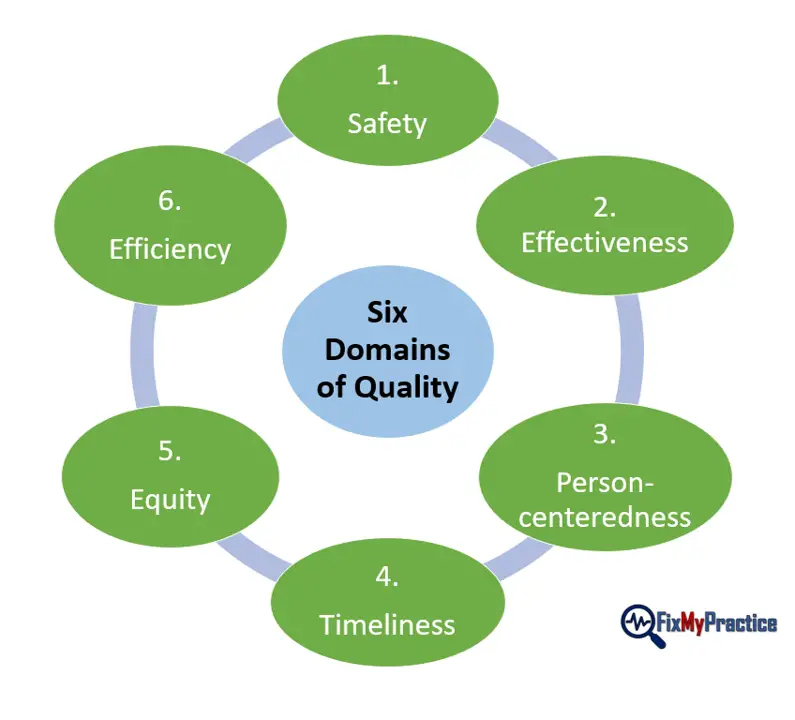Understanding the Six Domains of Care Quality
In health and social care, quality is crucial. However, that’s where a huge challenge lies. To bridge the gap between what we know is good care versus what care users actually receive, the Institute of Medicine released a report outlining these concerns. The report also outlined the six domains of care quality, which we’ll explore in this article.
The difference between current and ideal care isn’t a simple concept. It requires systemic changes in the six domains. To get an idea of where the changes need to occur, these six domains provide simple but actionable steps systems can take.

The Six Domains of Care Quality
The six domains of care quality are:
- Safety
- Effectiveness
- Patient-centeredness
- Timeliness
- Equity
- Efficiency
For a comprehensive view of the quality of care framework, read this article on care quality framework.
Safety in Care
The ancient maxim, “do no harm,” creates a foundation for this principle. The goal of healthcare should be to improve a patient’s outcome without causing harm in the process. From mistakes with medical procedures to more challenging outcomes such as attitudes towards healthcare, healthcare providers need to ensure that their practices do not cause harm.
In order to achieve this goal in any area of healthcare, safety must be a property of the system. Each system or area of healthcare can look at their processes, find areas where safety is at risk, and then work at improving or resolving those areas. Building a safety culture relies on both processes and the people involved.
Thus, safety is one of the most important of the domains of care quality.
Effectiveness in Care
An effective treatment plan is one that matches evidence-based medicine. It should neither underuse or overuse the best available techniques.
For example, an elderly patient who would benefit from a beta-blocker should receive that medication. A child with a simple ear infection should not receive a broad-spectrum antibiotic when a more targeted one is needed. The goal is to review a patient’s current condition and needs and then provide the most appropriate treatment regimen possible.
To achieve this goal in patient care, providers must have a firm grasp of current evidence when it comes to providing medical treatments. This is not a one-time goal but an ongoing improvement process.
Keeping up-to-date on the latest treatments, technologies, and outcomes ensures that patients receive treatment that will effectively manage their condition. Using decision trees and algorithms are common techniques that allow providers to prescribe the appropriate treatment without over- or under-treating in the process.
Patient-Centeredness in Care
Over the last few years, there has been an increase in interest in ensuring person-centeredness in care. Thus, it is no surprise that it is one of the six identified domains of care quality.
Each patient is unique and should be treated as such. Two patients could display to a healthcare system with the same condition. However, each should be viewed as unique as they will have individual culture, social context, and specific needs.
This means that instead of blindly treating the condition, providers must take care to look at the entire person throughout their treatment plan. This means that even patients who have the same diagnosis may receive significantly different treatments.
A key to patient-centered care is having the patient play an active role in his or her own care. That concept is especially important today with greater chronic illnesses that require life-long treatment and monitoring.
Healthcare systems often personalize treatment plans by providing initial questionnaires to their patients or using similar methods to achieve a basic understanding of who they’re providing healthcare. This model may change depending on the setting but should always come back to the patient’s needs at the centre.
Timeliness in Care
Timeliness is likely one of the most common complaints observed from patients today. Consider the average emergency department. Although some systems are able to see patients in a timely manner, many have stories where they had to wait a significant number of hours before receiving treatment. Not only can this delay be frustrating, it may also be life-threatening.
Healthcare systems can often achieve this by using models that focus on limiting waiting times regardless of the healthcare provided. Consider the barriers that prevent or delay treatment. Focusing on breaking down these barriers can allow patients to receive diagnosis, treatment, or even preventative care in a timely manner.
In the emergency department, for example, some systems use a nurse at the door to triage patients and get them into the appropriate treatment room. This change often works well for an emergency department but each area of healthcare can develop its own system.
Equity in Care
Every person deserves high-quality care. Multiple studies done across demographics show significant disparities when it comes to receiving appropriate care. From racial to gender disparities, individuals report receiving excellent or poor treatment based on this information. Race, ethnicity, gender, and income should never be barriers when it comes to receiving care.
Changing healthcare delivery to improve outcomes for each person often means taking a look at the explicit and implicit biases in the healthcare system. Some studies show that women who report pain receive less attention than men who report the same level of pain.
Healthcare providers should be aware of the current biases in the system and work to change their own mindset. Having health care delivery set-up so that it removes these biases is a challenge but desperately needed. Biases are going to vary in each healthcare system and area. Finding underserved populations may require significant study and work to correct these problems.
Efficiency in Care
A healthcare system that meets everyone’s needs buts ends up thousands of dollars in debt isn’t a good system. That’s why efficiency is part of the six domains of care quality.
Even healthcare systems that meet their budget should understand that reducing waste is an important goal. With a greater strain on systems to provide more and more services, reducing waste allows them to be more efficient and ultimately deliver a better system to their patients.
When it comes to reducing waste, money isn’t the only outcome to consider. Consider wasted opportunities such as community outreach programs to improve wellness or opportunities to provide education to patients in a hospital setting and prevent re-admissions.
Waste can be as simple as improving workflow to allow providers to be more efficient in their daily care. It may also mean being more efficient with supplies, equipment, physical space, and ideas. The goal of improving efficiency also isn’t static but will need to be reviewed and monitored on a frequent basis.
This article on total quality management may also interest you. However, if you are thinking of improving your processes, these articles on process improvement plan and process improvement tools may be useful.
Conclusion – Domains of Care Quality
The six quality domains offer a useful framework not only to assess the quality of health and social care, but also to design the right solutions.
It is important to note that different countries apply the six domains of care quality differently. For example, here in the UK, the Care Quality Commission uses 5 domains: safe, effective, caring, responsive to people’s needs and well-led.






[…] For more on the dimensions of quality, read our article on the six domains of quality. […]